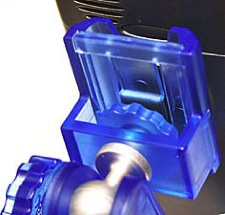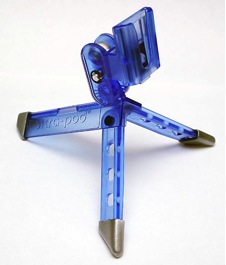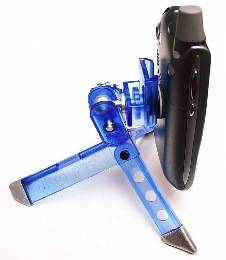The Cellpod's documentation recommends letting the adhesive "cure" for 12 hours before putting any strain on the button. I recommend you wait the long hours, just in case. I didn't and no problem, but you don't know that from me, and best not to tempt fate anyway.
 With the button on the Treo, make sure the battery door itself securely snaps into place before you go any further. The door�s two catches, top and bottom, will stand all alone between you and disaster. To test integrity, I gave the door/button/mounting considerable grief, and only had a problem if the battery door wasn't clunked firmly into its catches.
With the button on the Treo, make sure the battery door itself securely snaps into place before you go any further. The door�s two catches, top and bottom, will stand all alone between you and disaster. To test integrity, I gave the door/button/mounting considerable grief, and only had a problem if the battery door wasn't clunked firmly into its catches.
Everything checked out okay? Then snap the button into the plastic holder on top of the Cellpod. It's a loose fit, but a little spring-loaded catch at the bottom of the slot clacks over to capture the button in the slot. Tighten the thumbwheel.
 For positioning the camera, the Cellpod provides a ball socket as well as a detent-equipped elevation socket. With these adjustments, plus the mounting head itself, it's quite simple to point the Treo wherever you want, precisely and dependably, and tighten it down so it stays put. Once mounted, check the legs' sturdiness, and if the camera wobbles even a little bit, weigh the leg(s) down with something - a few ounces is plenty - or apply a strip of high-tech duct tape.
For positioning the camera, the Cellpod provides a ball socket as well as a detent-equipped elevation socket. With these adjustments, plus the mounting head itself, it's quite simple to point the Treo wherever you want, precisely and dependably, and tighten it down so it stays put. Once mounted, check the legs' sturdiness, and if the camera wobbles even a little bit, weigh the leg(s) down with something - a few ounces is plenty - or apply a strip of high-tech duct tape.
Next step, click pictures. Remember the advice in the previous article in this series, and touch the screen icon lightly with the stylus. Ho-o-o-ld the stylus to the screen, and when you're ready to click, pull away. This system causes the least jarring of the camera, whether on the Cellpod or in your hand. Also remember that one of the useful purposes of any camera's self-timer is to allow motion to settle down before the shutter fires. Set up the "Prompt Sound" in your Treo 650. Choose a sound of several seconds duration, and by the time the shutter fires, any motion you caused by tapping the shutter release will have quieted down.
 The Treo won't come out of the quick-release without flipping the small plastic release. Loosen the thumbwheel and rotate the Treo on its side to make the catch visible and easily accessible.
The Treo won't come out of the quick-release without flipping the small plastic release. Loosen the thumbwheel and rotate the Treo on its side to make the catch visible and easily accessible.
The Cellpod is, well, short. So, to use it on things that aren't, well, short, it has to perch on a dresser, a chest of drawers, a refrigerator, or a flagpole. The simple solution is to collapse its legs and Velcro or duct tape the resulting "handle" to a real tripod, flagpole, or whatever you have handy. Alas, the product makes no provision for use on a larger tripod or other support.
In case you're wondering, and I just know you are, the button that fits the Treo onto the Cellpod is the type used for belt clips, so you might be able to make it do both jobs. Convenient as that sounds, however, a Treo unprotected by some kind of case could get badly scratched. Nuff said.
Conclusion >>
Copyright 1999-2016 TreoCentral. All rights reserved :
Terms of Use : Privacy Policy
TREO and TreoCentral are trademarks or registered trademarks of palm, Inc. in the United States and other countries;
the TreoCentral mark and domain name are used under license from palm, Inc.
The views expressed on this website are solely those of the proprietor, or
contributors to the site, and do not necessarily reflect the views of palm, Inc.
Read Merciful by Casey Adolfsson
 With the button on the Treo, make sure the battery door itself securely snaps into place before you go any further. The door�s two catches, top and bottom, will stand all alone between you and disaster. To test integrity, I gave the door/button/mounting considerable grief, and only had a problem if the battery door wasn't clunked firmly into its catches.
With the button on the Treo, make sure the battery door itself securely snaps into place before you go any further. The door�s two catches, top and bottom, will stand all alone between you and disaster. To test integrity, I gave the door/button/mounting considerable grief, and only had a problem if the battery door wasn't clunked firmly into its catches.
 For positioning the camera, the Cellpod provides a ball socket as well as a detent-equipped elevation socket. With these adjustments, plus the mounting head itself, it's quite simple to point the Treo wherever you want, precisely and dependably, and tighten it down so it stays put. Once mounted, check the legs' sturdiness, and if the camera wobbles even a little bit, weigh the leg(s) down with something - a few ounces is plenty - or apply a strip of high-tech duct tape.
For positioning the camera, the Cellpod provides a ball socket as well as a detent-equipped elevation socket. With these adjustments, plus the mounting head itself, it's quite simple to point the Treo wherever you want, precisely and dependably, and tighten it down so it stays put. Once mounted, check the legs' sturdiness, and if the camera wobbles even a little bit, weigh the leg(s) down with something - a few ounces is plenty - or apply a strip of high-tech duct tape.
 The Treo won't come out of the quick-release without flipping the small plastic release. Loosen the thumbwheel and rotate the Treo on its side to make the catch visible and easily accessible.
The Treo won't come out of the quick-release without flipping the small plastic release. Loosen the thumbwheel and rotate the Treo on its side to make the catch visible and easily accessible.